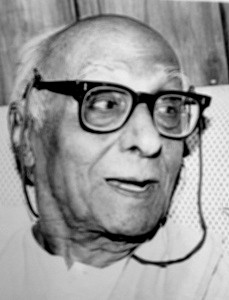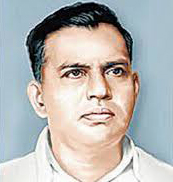Registered with the Registrar of Newspapers for India under R.N.I 53640/91
Vol. XXIX No. 8, August 1-15, 2019
Tamil Journalism – Post-Independence and its progress
by Mrinal Chatterjee
(Continued from last fortnight)
When Dinamani, sponsored by the Express Group, made its appearance in 1934, it electrified the atmosphere of Tamil journalism. It was a low-priced newspaper (six paise), but it was different from its rivals in presentation of news and views. Within a month of its publication, its circulation shot up and it was more than the combined circulation of all other Tamil papers.

A.N. Sivaraman
Dinamani had originally been started by S. Sadanand, who purchased the Indian Express from Varadarajulu Naidu. Both the papers later came into the possession of Ramnath Goenka. The first editor of Dinamani was T.S. Chockalingam, an ardent Congressman and a powerful writer. With him as joint editor was A.N. Sivaraman, who later notched new records in Tamil Journalism.
Both Chockalingam and Sivaraman were close associates even before they came to Dinamani. They had jointly produced a quarter anna tri-weekly, with news and views on the Satyagraha Movement, apart from trenchant criticism of the Government. Along with Swatantra Sanghu, another quarter-anna weekly edited by Sangu Ganesan, it became a rage at the height of the Satyagraha movement and sold like hot cakes. Chockalingam left Dinamani in 1943 and started a daily of his own, Dinasari, in 1944. The burden of running Dinamani fell on Sivaraman.
Sivaraman, a distinguished Tamil journalist often referred to as the Bhishma of Tamil Journalism, did not have much of an education in the conventional sense. He passed the secondary school course and joined a college in Tirunelveli but left it after barely six months. He was attracted by the Congress movement, especially by the ideals of Bal Gangadhar Tilak, and he took it upon himself to carry out the movement started by the Congress.
Although he discontinued college education, Sivaraman began educating himself through wide and purposive reading. Reading at all hours and far into the night became his habit. He was a prominent Congress volunteer in the Salt Satyagraha of 1930 and went to prison. He strayed into journalism when he joined Chockalingam in producing the tri-weekly Gandhi. After joining Dinamani, he switched over to its sister paper, Indian Express, for some years. He covered the San Francisco Conference for his paper and remained in the US for some years as its correspondent. He wrote articles on subjects like science and technology, agriculture and industry, political science and economics in a way which the common man could easily follow and understand. He was a teacher and guide for his readers and his mission was to educate his readers to be good citizens and educated patriots.
In 1942, S.B. Adityan, a barrister and a staunch Congressman, started a daily, Dina Thanthi, in Madurai, deliberately aimed at the lower class and the semi-literate population. The paper indulged in sensationalism and its four pages were filled with stories of crime, violence and cinema, written in an easy style and language. He provided readers what they liked to be fed and they lapped it up.
The paper’s circulation increased manifold and Adityan brought out editions from Madras and other centres. As the Dravidian parties, the Dravida Kazhagam (under E.V. Ramaswami Naicker) and the Dravida Munnetra Kazahgagam (under C.N. Annadurai) began to dominate the political scene in post-Independence Madras state (before it was renamed Tamil Nadu), Adityan resigned from the Congress and joined the Dravidian movement. His contribution to Tamil journalism was that he took the newspaper to the doorstep of the poor and downtrodden. Over the years, Dina Thanthi and its sister publications have not changed much in the type of journalism they began with. Neither has their popularity waned.
The path shown by Dina Thanthi has been followed by many other Tamil dailies. The most common features have been a) wide coverage of political warfare in Tamil Nadu, b) dominance of crime, sex and cinema, and c) multiple editions. Dinakaran followed this path and added better investigative stories. It is published from multiple centres. Unlike Dina Thanthi, it has an editorial. It has a good circulation and one reason for its popularity is said to be its anti-establishment posture.

T.V. Ramasubba Aiyer.
Another daily which has made its mark is Dinamalar, established by T.V. Ramasubba Aiyer, a Congressman of Tirunelveli. It was started in 1951 in Trivandrum and played an active role in the agitation for the merger of Tamil areas in Travancore with Tamil Nadu, and was very popular for that reason. At one stage, the paper’s office was raided by the police and its copies were seized. This happened when Pattom Thanu Pillai was the Chief Minister of the state.
After the success of the agitation, when Nagercoil and Kanyakumari were merged with Tamil Nadu, Ramasubba Aiyer moved to Tirunelveli in 1960 where Dinamalar concentrated on the problems of the local people, and in getting the people’s grievances redressed. Its circulation went up and an edition was started at Tiruchi in 1966, followed by one in Madras in 1979 and Erode in 1984.
Dinamalar introduced offset printing in 1981 and adopted other modern techniques of printing. A feature of the paper is its photographic coverage, which gives it a unique place in Tamil journalism. During the Pope’s visit to Madras in 1986, it came out with a four-page photo feature of the Pope’s engagements in the city.
A Tamil daily which was the result of cooperative efforts is Makkal Kural, which appeared in Madras in 1973. It emerged from the ashes of Navamani, founded by a cooperative society, which got into trouble with the DMK Government and had finally to close down. One of its leading journalists, Shanmuga Vel, floated Newsmen Associates in 1972 and Makkal Kural came into being the next year. It had an able and experienced editor in T.R. Ramaswami, who was formerly connected with Patriot and Link of New Delhi and with the Federation of Working Journalists. TRR, as he was known to his readers, had a powerful pen and a head for facts and figures. In 1982, he started an evening English daily, News Today.
Tamil language newspapers have been published from outside the country from the pre-Independence era. There was a Tamil newspaper titled Tamil Nesan in Kuala Lumpur, Malaysia since 1924. It was the lone Tamil newspaper in Malaysia till Tamil Osai was launched in 1981. Later, it was rechristened Makkal Osai, which in English means People’s Voice. Thamizhavel G. Sarangapani launched Tamil Murasuin Singapore on 1935. By mid-2012, it was the only Tamil language newspaper in Singapore.
Several Tamil language newspapers have been published from Sri Lanka, the best known being Virakesari. It was first published on August 6, 1930 by P. P. R. Subramanian, an entrepreneur and journalist from Avanipatti Village in Tamil Nadu. Subramanian guided the publication for over 20 years, during which it focused on the rights and grievances of the plantation workers, capturing the attention of the Tamil-speaking population. By mid-2012, it was the most widely circulated and read newspaper among the Tamil-speaking population in Sri Lanka. In 2005, Virakesari’s e-paper was launched, which is said to be the world’s first in Tamil.
Among other Tamil language newspapers published from Sri Lanka were Eelamurasu, Eeelanadu and Uthayan. All the three papers were published from Jaffna, a Tamil majority area. Uthayan was founded in 1985 by journalist Nadesapillai Vithayatharan. Thinakkural was founded by Pon Rajagobal, former editor of Virakesari in 1977, and Sudar Oli was founded in Colombo on 10 September 2000 as a weekly newspaper. It became a newspaper on 29 October 2001. Nadesapillai Vithayatharan became the paper’s editor in 2002.
Almost all Tamil language newspapers in Sri Lanka suffered heavily during the conflict beginning early 1980s. Besides Sri Lanka and Malaysia, Tamil newspapers are also published from countries like Singapore, the UK, Canada, Australia and several countries in West Asia.
By end-2012, Daily Thanthi was the largest-read daily in Tamil Nadu. According to the Indian Readership Survey Q-4 2012, it occupies the seventh position among the top ten publications of the country. The Hindi daily Dainik Jagran tops the list. Daily Thanthi is followed by Dinakaran and Dinamalar. Among the Tamil magazines, Kumudam is the largest circulated. It occupies sixth position in the list of top ten language magazines of the country. Malayalam periodical Vanitha tops the list.
Newspapers across India and languages have had political leanings, some overtly, some covertly. But an interesting feature of Tamil journalism is that it has had distinct, in-your-face political leanings. Several newspapers were open and vocal about their leanings. In the pre-Independence era, it could be divided into three groups: the Dravidian Press, the Nationalist Press, the Muslim Press. Post-Independence, the trend continues; albeit with different rallying points (Courtesy: RIND Survey, March 2019).
(Concluded)

